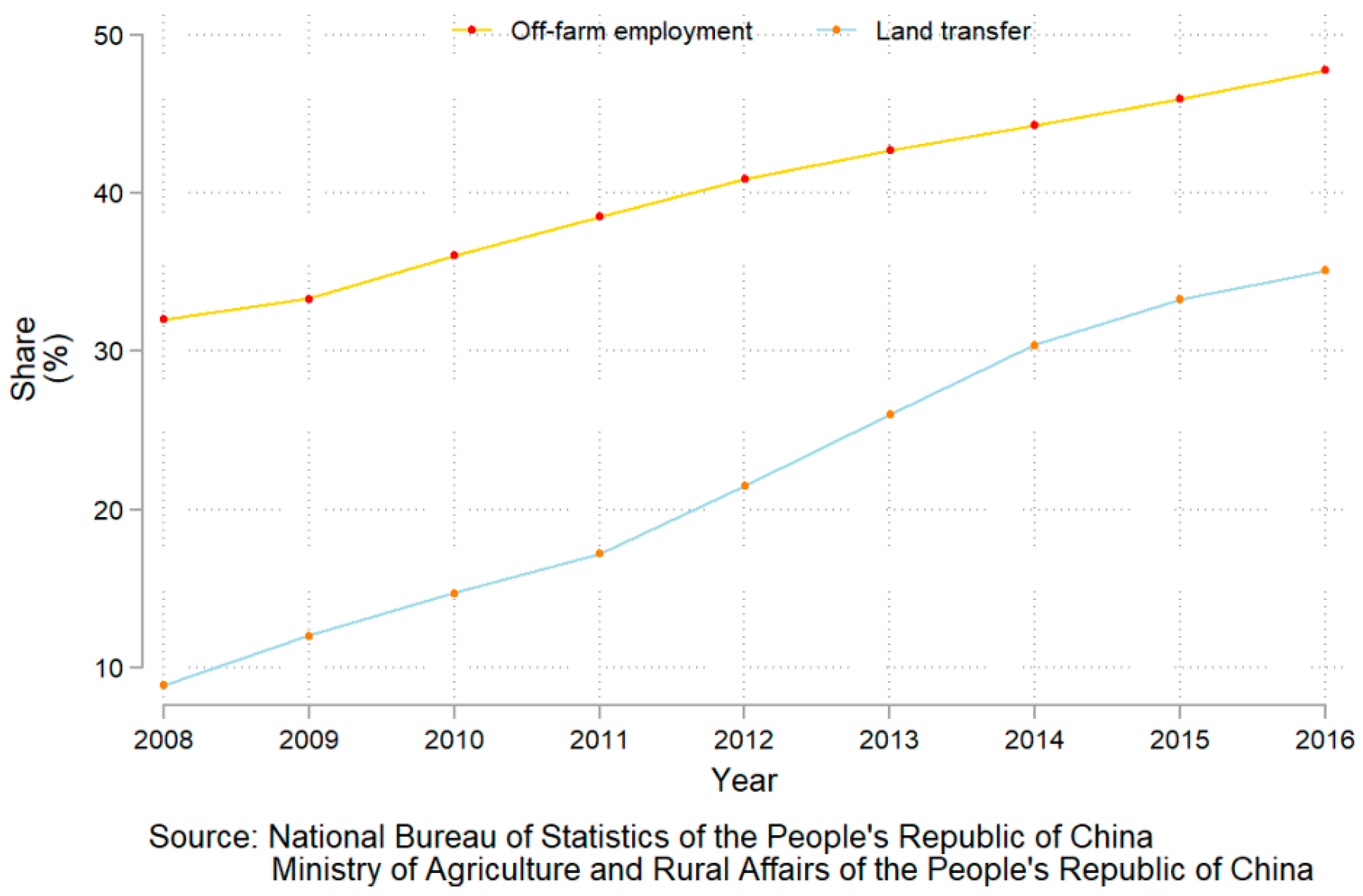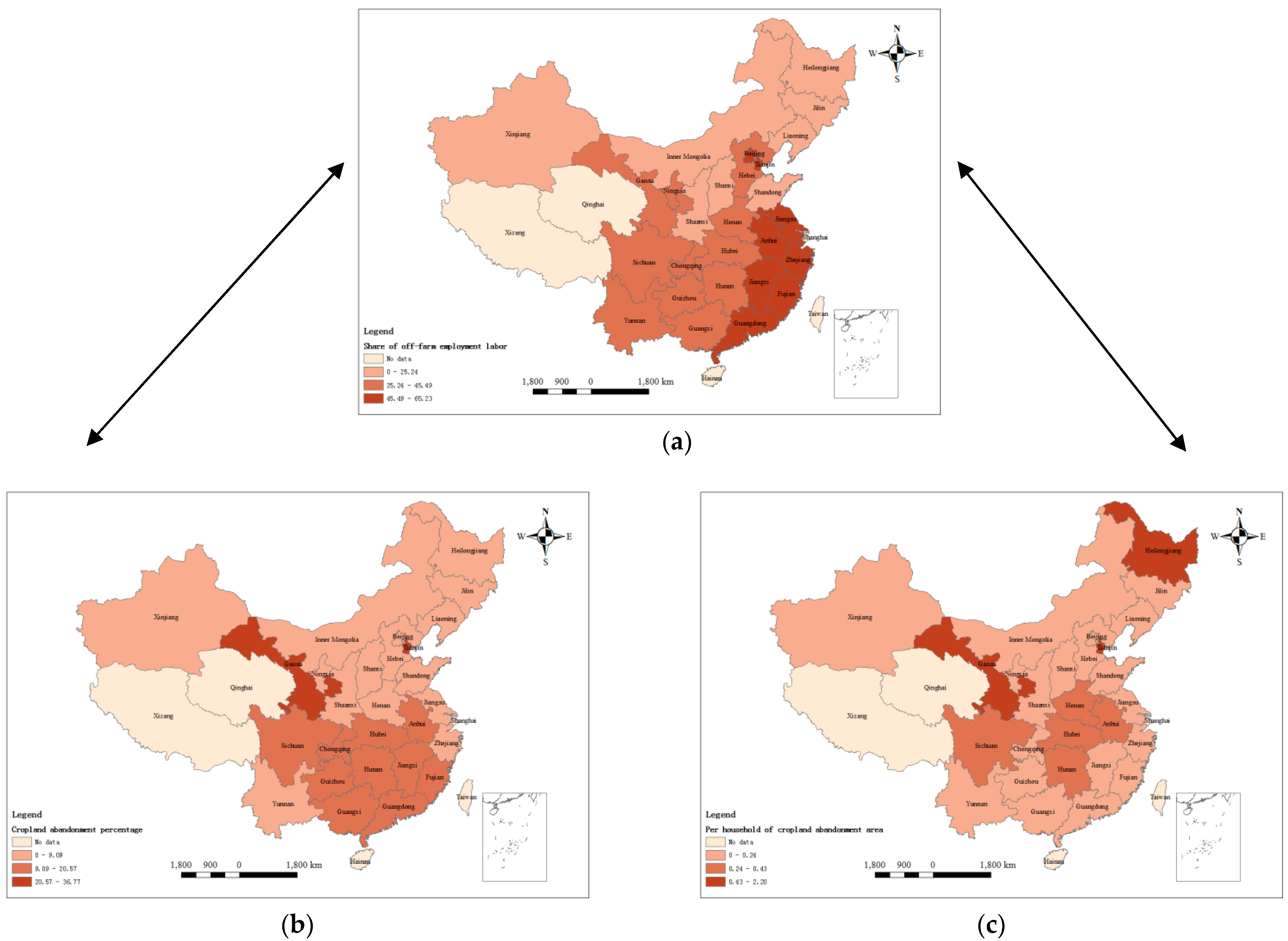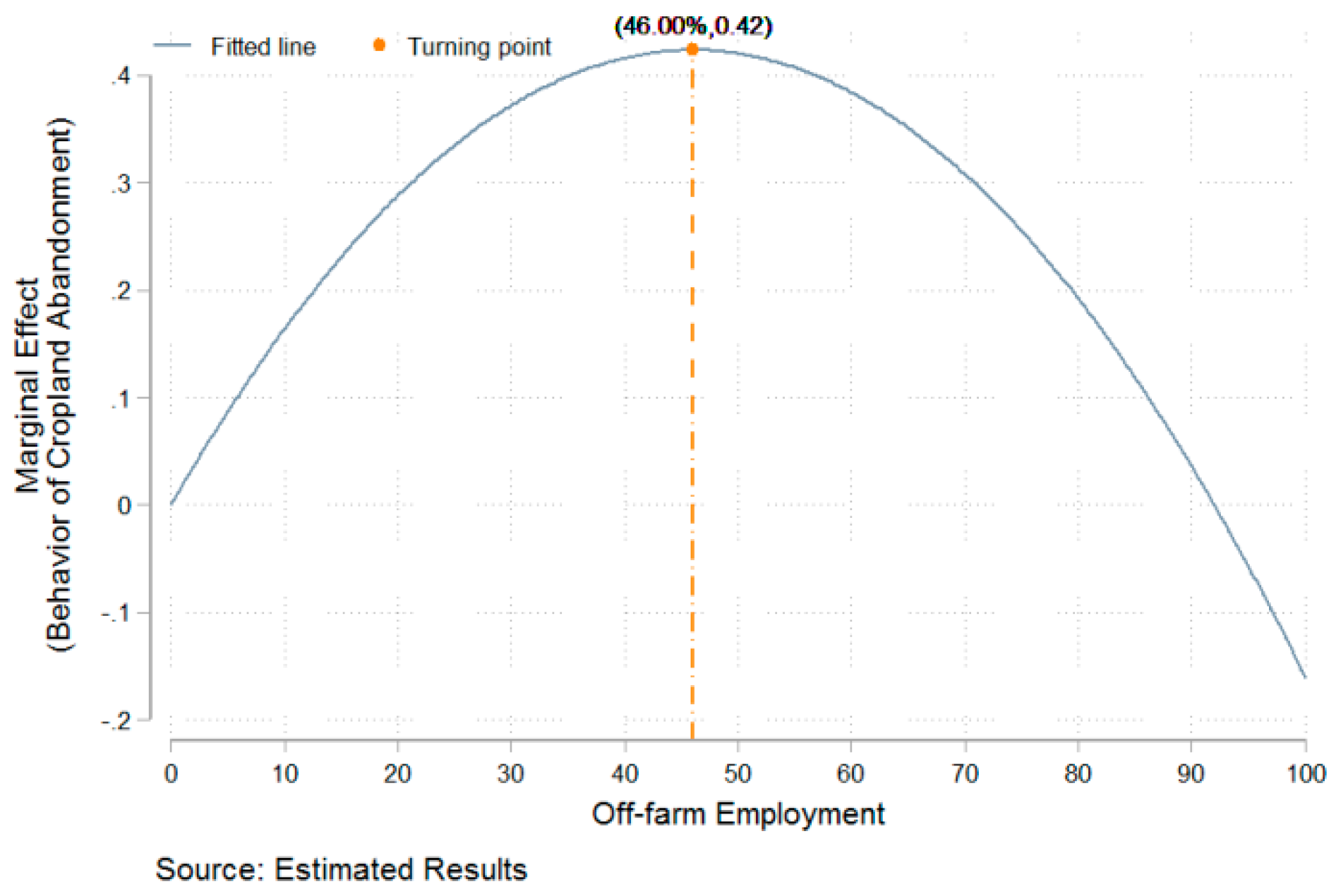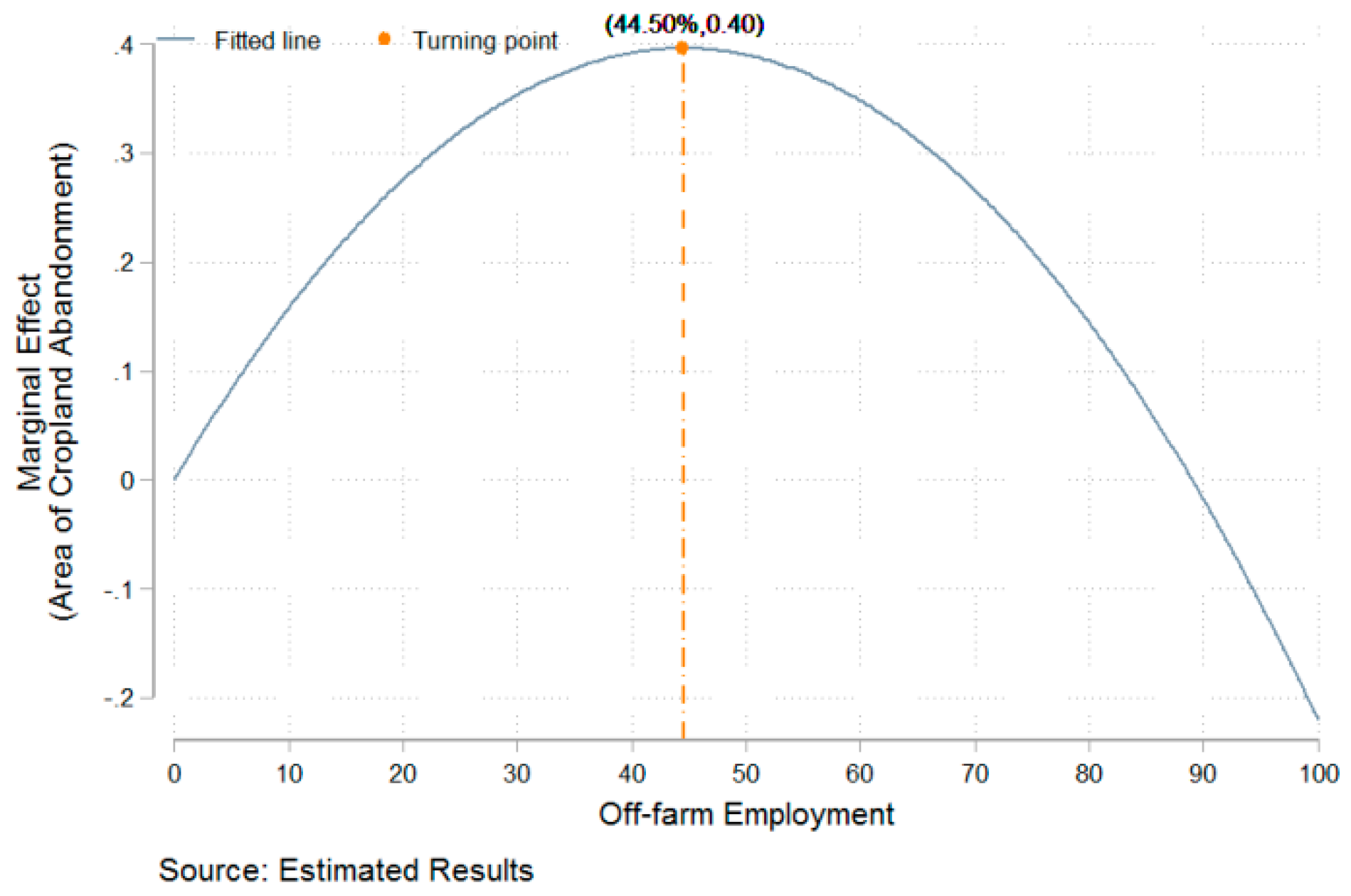Labor Off-Farm Employment and Cropland Abandonment in Rural China: Spatial Distribution and Empirical Analysis
Abstract
1. Introduction
- (1)
- From a spatial perspective, what is the distribution of off-farm labor and cropland abandonment in rural China?
- (2)
- From a quantitative perspective, does off-farm employment inevitably result in cropland abandonment?
2. Theoretical Analyses
3. Materials and Methods
3.1. Data Source
3.2. Econometric Method
3.3. Variable Design
3.3.1. Dependent Variables
3.3.2. Focal Variables
3.3.3. Control Variables
4. Results
4.1. Spatial Distribution Analysis
4.2. Empirical Analysis
4.2.1. Off-Farm Employment Impacts Behavior of Cropland Abandonment (IV-Probit)
4.2.2. Off-Farm Employment Effects Area of Cropland Abandonment (IV-Tobit)
4.2.3. Labor Off-Farm Employment Does Not Inevitably Result in Cropland Abandonment
4.2.4. Robustness Checks
5. Discussion
6. Conclusions
- (1)
- The spatial distribution of off-farm employment and cropland abandonment differs among regions. A region with a higher ratio of off-farm employment shows more cropland abandonment but a lower average area of cropland abandonment.
- (2)
- Off-farm labor has a significant and positive correlation with cropland abandonment. However, its square shows a significant and negative correlation with cropland abandonment; i.e., there is an inverted U-shaped relationship between off-farm employment and cropland abandonment, with the turning point occurring at 46.00% off-farm employment.
- (3)
- Off-farm employment has a significant and positive correlation with the area of cropland abandonment. However, its square has a significant and negative correlation with the area; i.e., there is an inverted U-shaped relationship between off-farm employment and area, with the turning point occurring at 44.50% off-farm employment.
Author Contributions
Funding
Acknowledgments
Conflicts of Interest
References
- Restuccia, D.; Rogerson, R. Misallocation and Productivity. Rev. Econ. Dyn. 2013, 16, 1–10. [Google Scholar] [CrossRef]
- Hsieh, C.-T.; Klenow, P.J. Misallocation and Manufacturing Tfp in China and India. Q. J. Econ. 2009, 124, 1403–1448. [Google Scholar] [CrossRef]
- Adamopoulos, T.; Restuccia, D. Land Reform and Productivity: A Quantitative Analysis with Micro Data; Unpublished manuscript; University of Toronto: Toronto, ON, Canada, 2014; pp. 1667–1697. [Google Scholar]
- Restuccia, D.; Santaeulalia-Llopis, R. Land Misallocation and Productivity; National Bureau of Economic Research: Cambridge, MA, USA, 2017. [Google Scholar]
- Deng, X.; Huang, J.; Rozelle, S.; Zhang, J.; Li, Z. Impact of Urbanization on Cultivated Land Changes in China. Land Use Policy 2015, 45, 1–7. [Google Scholar] [CrossRef]
- Li, Y.; Li, Y.; Westlund, H.; Liu, Y. Urban–Rural Transformation in Relation to Cultivated Land Conversion in China: Implications for Optimizing Land Use and Balanced Regional Development. Land Use Policy 2015, 47, 218–224. [Google Scholar] [CrossRef]
- Nguyen, T.T.; Nguyen, L.D.; Lippe, R.S.; Grote, U. Determinants of Farmers’ Land Use Decision-Making: Comparative Evidence from Thailand and Vietnam. World Dev. 2017, 89, 199–213. [Google Scholar] [CrossRef]
- Long, H.; Wu, X.; Wang, W.; Dong, G. Analysis of Urban-Rural Land-Use Change During 1995-2006 and Its Policy Dimensional Driving Forces in Chongqing, China. Sensors 2008, 8, 681–699. [Google Scholar] [CrossRef] [PubMed]
- Chen, R.; Ye, C.; Cai, Y.; Xing, X.; Chen, Q. The Impact of Rural out-Migration on Land Use Transition in China: Past, Present and Trend. Land Use Policy 2014, 40, 101–110. [Google Scholar] [CrossRef]
- Long, H.; Tu, S.; Ge, D.; Li, T.; Liu, Y. The Allocation and Management of Critical Resources in Rural China under Restructuring: Problems and Prospects. J. Rural Stud. 2016, 47, 392–412. [Google Scholar] [CrossRef]
- Xu, D.; Guo, S.; Xie, F.; Liu, S.; Cao, S. The Impact of Rural Laborer Migration and Household Structure on Household Land Use Arrangements in Mountainous Areas of Sichuan Province, China. Habitat Int. 2017, 70, 72–80. [Google Scholar] [CrossRef]
- Ji, X.; Qian, Z.; Zhang, L.; Zhang, T. Rural Labor Migration and Households’ Land Rental Behavior: Evidence from China. China World Econ. 2018, 26, 66–85. [Google Scholar] [CrossRef]
- Che, Y. Off-Farm Employments and Land Rental Behavior: Evidence from Rural China. China Agric. Econ. Rev. 2016, 8, 37–54. [Google Scholar] [CrossRef]
- Deininger, K.; Jin, S. The Potential of Land Rental Markets in the Process of Economic Development: Evidence from China. J. Dev. Econ. 2005, 78, 241–270. [Google Scholar] [CrossRef]
- Gan, N.; Yin, Z. China Household Finance Survey Report 2014; Southwestern University of Finance and Economics Press: Chengdu, China, 2015. [Google Scholar]
- Yan, J.; Yang, Z.; Li, Z.; Li, X.; Xin, L.; Sun, L. Drivers of Cropland Abandonment in Mountainous Areas: A Household Decision Model on Farming Scale in Southwest China. Land Use Policy 2016, 57, 459–469. [Google Scholar] [CrossRef]
- Aide, T.M.; Grau, H.R. Globalization, Migration, and Latin American Ecosystems. Science 2004, 305, 1915–1916. [Google Scholar] [CrossRef] [PubMed]
- Van Doorn, A.M.; Bakker, M.M. The Destination of Arable Land in a Marginal Agricultural Landscape in South Portugal: An Exploration of Land Use Change Determinants. Landsc. Ecol. 2007, 22, 1073–1087. [Google Scholar] [CrossRef]
- Sikor, T.; Müller, D.; Stahl, J. Land Fragmentation and Cropland Abandonment in Albania: Implications for the Roles of State and Community in Post-Socialist Land Consolidation. World Dev. 2009, 37, 1411–1423. [Google Scholar] [CrossRef]
- Xie, H.; Wang, P.; Yao, G. Exploring the Dynamic Mechanisms of Farmland Abandonment Based on a Spatially Explicit Economic Model for Environmental Sustainability: A Case Study in Jiangxi Province, China. Sustainability 2014, 6, 1260–1282. [Google Scholar] [CrossRef]
- Lieskovský, J.; Bezák, P.; Špulerová, J.; Lieskovský, T.; Koleda, P.; Dobrovodská, M.; Bürgi, M.; Gimmi, U. The Abandonment of Traditional Agricultural Landscape in Slovakia—Analysis of Extent and Driving Forces. J. Rural Stud. 2015, 37, 75–84. [Google Scholar] [CrossRef]
- Xie, Y.; Jiang, Q. Land Arrangements for Rural—Urban Migrant Workers in China: Findings from Jiangsu Province. Land Use Policy 2016, 50, 262–267. [Google Scholar] [CrossRef]
- MacDonald, D.; Crabtree, J.; Wiesinger, G.; Dax, T.; Stamou, N.; Fleury, P.; Lazpita, J.G.; Gibon, A. Agricultural Abandonment in Mountain Areas of Europe: Environmental Consequences and Policy Response. J. Environ. Manag. 2000, 59, 47–69. [Google Scholar] [CrossRef]
- Benayas, J.R.; Martins, A.; Nicolau, J.M.; Schulz, J.J. Abandonment of Agricultural Land: An Overview of Drivers and Consequences. CAB Rev. Perspect. Agric. Vet. Sci. Nutr. Nat. Resour. 2007, 2, 1–14. [Google Scholar] [CrossRef]
- Gellrich, M.; Baur, P.; Koch, B.; Zimmermann, N.E. Agricultural Land Abandonment and Natural Forest Re-Growth in the Swiss Mountains: A Spatially Explicit Economic Analysis. Agric. Ecosyst. Environ. 2007, 118, 93–108. [Google Scholar] [CrossRef]
- Zhang, J. China’s Success in Increasing Per Capita Food Production. J. Exp. Bot. 2011, 62, 3707–3711. [Google Scholar] [CrossRef] [PubMed]
- Brown, D.G.; Johnson, K.M.; Loveland, T.R.; Theobald, D.M. Rural Land-Use Trends in the Conterminous United States, 1950–2000. Ecol. Appl. 2005, 15, 1851–1863. [Google Scholar] [CrossRef]
- Ramankutty, N.; Heller, E.; Rhemtulla, J. Prevailing Myths About Agricultural Abandonment and Forest Regrowth in the United States. Ann. Assoc. Am. Geogr. 2010, 100, 502–512. [Google Scholar] [CrossRef]
- Alcantara, C.; Kuemmerle, T.; Baumann, M.; Bragina, E.V.; Griffiths, P.; Hostert, P.; Knorn, J.; Müller, D.; Prishchepov, A.V.; Schierhorn, F. Mapping the Extent of Abandoned Farmland in Central and Eastern Europe Using Modis Time Series Satellite Data. Environ. Res. Lett. 2013, 8. [Google Scholar] [CrossRef]
- Hatna, E.; Bakker, M.M. Abandonment and Expansion of Arable Land in Europe. Ecosystems 2011, 14, 720–731. [Google Scholar] [CrossRef]
- Weissteiner, C.J.; Boschetti, M.; Böttcher, K.; Carrara, P.; Bordogna, G.; Brivio, P.A. Spatial Explicit Assessment of Rural Land Abandonment in the Mediterranean Area. Glob. Planet. Chang. 2011, 79, 20–36. [Google Scholar] [CrossRef]
- Xu, D.; Zhang, J.; Rasul, G.; Liu, S.; Xie, F.; Cao, M.; Liu, E. Household Livelihood Strategies and Dependence on Agriculture in the Mountainous Settlements in the Three Gorges Reservoir Area, China. Sustainability 2015, 7, 4850–4869. [Google Scholar] [CrossRef]
- Xu, D.; Peng, L.; Liu, S.; Su, C.; Wang, X.; Chen, T. Influences of Migrant Work Income on the Poverty Vulnerability Disaster Threatened Area: A Case Study of the Three Gorges Reservoir Area, China. Int. J. Disaster Risk Reduct. 2017, 22, 62–70. [Google Scholar] [CrossRef]
- Xu, D.; Liu, E.; Wang, X.; Tang, H.; Liu, S. Rural Households’ Livelihood Capital, Risk Perception, and Willingness to Purchase Earthquake Disaster Insurance: Evidence from Southwestern China. Int. J. Environ. Res. Public Health 2018, 15, 1319. [Google Scholar] [CrossRef] [PubMed]
- Xu, D.; Peng, L.; Liu, S.; Su, C.; Wang, X.; Chen, T. Influences of Sense of Place on Farming Households’ Relocation Willingness in Areas Threatened by Geological Disasters: Evidence from China. Int. J. Disaster Risk Sci. 2017, 8, 16–32. [Google Scholar] [CrossRef]
- Xu, D.; Peng, L.; Liu, S.; Wang, X. Influences of Risk Perception and Sense of Place on Landslide Disaster Preparedness in Southwestern China. Int. J. Disaster Risk Sci. 2018, 9, 167–180. [Google Scholar] [CrossRef]
- Sana, M.; Massey, D.S. Household Composition, Family Migration, and Community Context: Migrant Remittances in Four Countries. Soc. Sci. Q. 2005, 86, 509–528. [Google Scholar] [CrossRef]
- Dillon, A.; Mueller, V.; Salau, S. Migratory Responses to Agricultural Risk in Northern Nigeria. Am. J. Agric. Econ. 2011, 93, 1048–1061. [Google Scholar] [CrossRef]
- Stark, O.; Bloom, D.E. The New Economics of Labor Migration. Am. Econ. Rev. 1985, 75, 173–178. [Google Scholar]
- Xu, D.; Zhang, J.; Xie, F.; Liu, S.; Cao, M.; Liu, E. Influential Factors in Employment Location Selection Based on “Push-Pull” Migration Theory—A Case Study in Three Gorges Reservoir Area in China. J. Mt. Sci. 2015, 12, 1562–1581. [Google Scholar] [CrossRef]
- Cheng, Y.S.; Chung, K.S. Designing Property Rights over Land in Rural China. Econ. J. 2017. [Google Scholar] [CrossRef]
- Meng, X. Labor Market Outcomes and Reforms in China. J. Econ. Perspect. 2012, 26, 75–102. [Google Scholar] [CrossRef]
- Burgess, R. Land and Welfare: Theory and Evidence from China; London School of Economics: London, UK, 2001. [Google Scholar]
- Yang, J.; Huang, Z.; Zhang, X.; Reardon, T. The Rapid Rise of Cross-Regional Agricultural Mechanization Services in China. Am. J. Agric. Econ. 2013, 95, 1245–1251. [Google Scholar] [CrossRef]
- Newey, W.K. Efficient Estimation of Limited Dependent Variable Models with Endogenous Explanatory Variables. J. Econ. 1987, 36, 231–250. [Google Scholar] [CrossRef]
- Huang, J.; Gao, L.; Rozelle, S. The Effect of Off-Farm Employment on the Decisions of Households to Rent out and Rent in Cultivated Land in China. China Agric. Econ. Rev. 2012, 4, 5–17. [Google Scholar] [CrossRef]
- Cavicchioli, D.; Bertoni, D.; Pretolani, R. Farm Succession at a Crossroads: The Interaction among Farm Characteristics, Labour Market Conditions, and Gender and Birth Order Effects. J. Rural Stud. 2018, 61, 73–83. [Google Scholar] [CrossRef]
- Prishchepov, A.V.; Müller, D.; Dubinin, M.; Baumann, M.; Radeloff, V.C. Determinants of Agricultural Land Abandonment in Post-Soviet European Russia. Land Use Policy 2013, 30, 873–884. [Google Scholar] [CrossRef]
- Queiroz, C.; Beilin, R.; Folke, C.; Lindborg, R. Farmland Abandonment: Threat or Opportunity for Biodiversity Conservation? A Global Review. Front. Ecol. Environ. 2014, 12, 288–296. [Google Scholar] [CrossRef]
- Rudel, T.K.; Bates, D.; Machinguiashi, R. A Tropical Forest Transition? Agricultural Change, out-Migration, and Secondary Forests in the Ecuadorian Amazon. Ann. Assoc. Am. Geogr. 2002, 92, 87–102. [Google Scholar] [CrossRef]
- Rudel, T.K.; Coomes, O.T.; Moran, E.; Achard, F.; Angelsen, A.; Xu, J.; Lambin, E. Forest Transitions: Towards a Global Understanding of Land Use Change. Glob. Environ. Chang. 2005, 15, 23–31. [Google Scholar] [CrossRef]




| Variables | Definition and Assignment | Mean | S.D. c |
|---|---|---|---|
| Dependent variables | |||
| Abandonment | Whether rural households abandon cropland (0 = no; 1 = yes) | 0.12 | 0.32 |
| Abandonment size | The area of cropland abandonment in rural households (mu a) | 0.33 | 1.65 |
| Focal variable | |||
| Off-farm employment | The share of off-farm employment laborers in total laborers (%) | 0.40 | 0.39 |
| Householder variables | |||
| Age | Age of household head in years (year) | 53.80 | 13.20 |
| Education | Whether householder has received a high school diploma or above (0 = no; 1 = yes) | 0.12 | 0.32 |
| Household variables | |||
| Land area | Managing land area of rural households (mu a) | 5.72 | 9.60 |
| Land right | Whether rural households get the land confirmation certificate (0 = no; 1 = yes) | 0.41 | 0.49 |
| Land rent-out | Whether there is rent-out land in rural households (0 = no; 1 = yes) | 0.69 | 0.46 |
| Old | The number of people over 64 years old engaged in agricultural production (number) | 0.15 | 0.46 |
| Labor size | Total labor force of rural households (number) | 2.74 | 1.60 |
| Distance | Distance from households to the nearest business center (km) | 7.12 | 9.18 |
| Agricultural assets | Per capita of current market value of all the agricultural assets that a household possesses (104 Yuan b/person) | 0.08 | 0.53 |
| Fixed assets | Per capita of current market value of all the fixed assets that a household possesses (104 Yuan b/person) | 4.32 | 16.75 |
| Plain | Whether households are located on a plain (0 = no; 1 = yes) | 0.41 | 0.49 |
| Hill | Whether households are located on a hill (0 = no; 1 = yes) | 0.34 | 0.47 |
| Mountain | Whether households are located on a mountain (0 = no; 1 = yes) | 0.25 | 0.43 |
| Variables | Model (1) | Model (2) | Model (3) | Model (4) |
|---|---|---|---|---|
| Off-farm employment | 0.0646 *** | 0.0637 *** | 0.0758 *** | 0.0184 *** |
| (0.0040) | (0.0076) | (0.0056) | (0.0016) | |
| Off-farm employment2 | −0.0007 *** | −0.0007 *** | −0.0008 *** | −0.0002 *** |
| (0.0000) | (0.0001) | (0.0001) | (0.0000) | |
| Age | −0.0325 *** | −0.0079 *** | ||
| (0.0068) | (0.0017) | |||
| Age2 | 0.0004 *** | 0.0001 *** | ||
| (0.0001) | (0.0000) | |||
| Education | 0.0293 | 0.0071 | ||
| (0.0496) | (0.0120) | |||
| Land area | 0.0026 * | 0.0006 * | ||
| (0.0014) | (0.0003) | |||
| Land right | −0.0268 | −0.0065 | ||
| (0.0333) | (0.0081) | |||
| Land rent-out | −0.3089 *** | −0.0750 *** | ||
| (0.0475) | (0.0106) | |||
| Old | −0.0085 | −0.0021 | ||
| (0.0351) | (0.0085) | |||
| Labor size | −0.1769 *** | −0.0429 *** | ||
| (0.0198) | (0.0053) | |||
| Distance | 0.0013 | 0.0003 | ||
| (0.0017) | (0.0004) | |||
| Fixed assets | −0.0297 * | −0.0072 * | ||
| (0.0173) | (0.0042) | |||
| Agricultural assets | −0.2034 * | −0.0494 * | ||
| (0.1058) | (0.0256) | |||
| Hill | 0.0750 * | 0.0182 * | ||
| (0.0453) | (0.0109) | |||
| Mountain | 0.1260 ** | 0.0306 ** | ||
| (0.0503) | (0.0121) | |||
| Constant | −1.2225 *** | −1.3527 *** | −0.1847 | |
| (0.0395) | (0.2190) | (0.2646) | ||
| Province dummies | No | Yes | Yes | Yes |
| Endogenous Wald χ2 | 436.64 *** | 183.69 *** | 676.25 *** | 676.25 *** |
| Observations | 8031 | 8031 | 8031 | 8031 |
| Variables | Model (1) | Model (2) | Model (3) | Model (4) |
|---|---|---|---|---|
| Off-farm employment | 0.7209 *** | 0.5467 *** | 0.7129 *** | 0.0178 *** |
| (0.0590) | (0.0738) | (0.0845) | (0.0013) | |
| Off-farm employment2 | −0.0080 *** | −0.0059 *** | −0.0076 *** | −0.0002 *** |
| (0.0007) | (0.0009) | (0.0010) | (0.0000) | |
| Age | −0.3035 *** | −0.0076 *** | ||
| (0.0704) | (0.0017) | |||
| Age2 | 0.0034 *** | 0.0001 *** | ||
| (0.0006) | (0.0000) | |||
| Education | 0.3087 | 0.0077 | ||
| (0.5574) | (0.0138) | |||
| Land area | 0.0758 *** | 0.0019 *** | ||
| (0.0218) | (0.0005) | |||
| Land right | −0.4077 | −0.0102 | ||
| (0.3233) | (0.0080) | |||
| Land rent-out | −2.8267 *** | −0.0707 *** | ||
| (0.3875) | (0.0095) | |||
| Old | −0.0859 | −0.0021 | ||
| (0.3382) | (0.0085) | |||
| Labor size | −1.5602 *** | −0.0390 *** | ||
| (0.2132) | (0.0040) | |||
| Distance | 0.0143 | 0.0004 | ||
| (0.0166) | (0.0004) | |||
| Fixed assets | −0.3719 ** | −0.0093 ** | ||
| (0.1718) | (0.0043) | |||
| Agricultural assets | −3.0541 ** | −0.0764 *** | ||
| (1.2333) | (0.0291) | |||
| Hill | 0.3120 | 0.0078 | ||
| (0.4327) | (0.0107) | |||
| Mountain | 0.2234 | 0.0056 | ||
| (0.4777) | (0.0119) | |||
| Constant | −12.4638 *** | −12.3135 *** | −3.1040 | |
| (0.7721) | (1.8446) | (2.8156) | ||
| Province dummies | No | Yes | Yes | Yes |
| Endogenous Wald χ2 | 856.33 *** | 276.69 *** | 697.48 *** | 697.48 *** |
| Observations | 8031 | 8031 | 8031 | 8031 |
| Variables | Behavior of Cropland Abandonment | Area of Cropland Abandonment | ||
|---|---|---|---|---|
| Model (1) | Model (2) | Model (3) | Model (4) | |
| Off-farm employment | 0.0788 *** | 0.0768 *** | 0.8636 *** | 1.3886 *** |
| (0.0032) | (0.0017) | (0.1036) | (0.1349) | |
| Off-farm employment2 | −0.0008 *** | −0.0008 *** | −0.0093 *** | −0.0144 *** |
| (0.0000) | (0.0000) | (0.0011) | (0.0014) | |
| Control variables | Yes | Yes | Yes | Yes |
| Province dummies | Yes | Yes | Yes | Yes |
| Endogenous Wald χ2 | 785.62 *** | 386.41 *** | 1300.00 *** | 179.62 *** |
| Observations | 3266 | 7996 | 3266 | 7996 |
© 2018 by the authors. Licensee MDPI, Basel, Switzerland. This article is an open access article distributed under the terms and conditions of the Creative Commons Attribution (CC BY) license (http://creativecommons.org/licenses/by/4.0/).
Share and Cite
Deng, X.; Xu, D.; Qi, Y.; Zeng, M. Labor Off-Farm Employment and Cropland Abandonment in Rural China: Spatial Distribution and Empirical Analysis. Int. J. Environ. Res. Public Health 2018, 15, 1808. https://doi.org/10.3390/ijerph15091808
Deng X, Xu D, Qi Y, Zeng M. Labor Off-Farm Employment and Cropland Abandonment in Rural China: Spatial Distribution and Empirical Analysis. International Journal of Environmental Research and Public Health. 2018; 15(9):1808. https://doi.org/10.3390/ijerph15091808
Chicago/Turabian StyleDeng, Xin, Dingde Xu, Yanbin Qi, and Miao Zeng. 2018. "Labor Off-Farm Employment and Cropland Abandonment in Rural China: Spatial Distribution and Empirical Analysis" International Journal of Environmental Research and Public Health 15, no. 9: 1808. https://doi.org/10.3390/ijerph15091808
APA StyleDeng, X., Xu, D., Qi, Y., & Zeng, M. (2018). Labor Off-Farm Employment and Cropland Abandonment in Rural China: Spatial Distribution and Empirical Analysis. International Journal of Environmental Research and Public Health, 15(9), 1808. https://doi.org/10.3390/ijerph15091808







